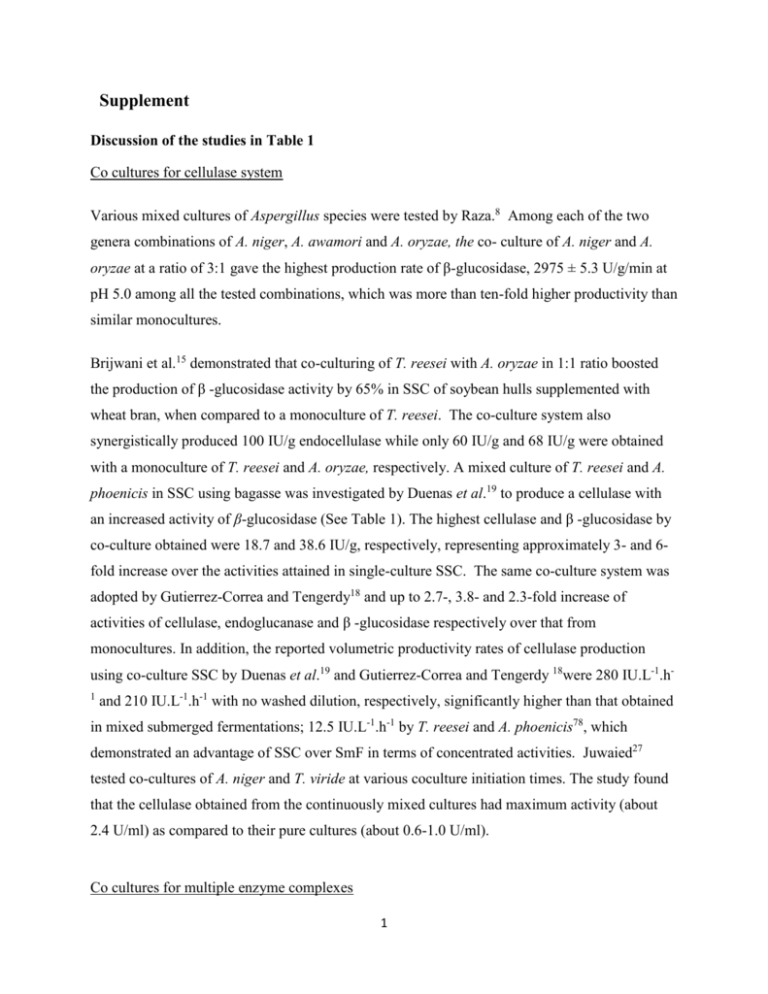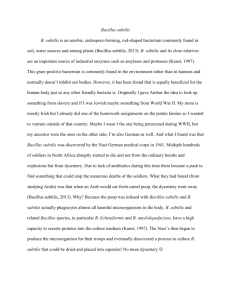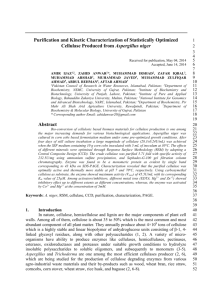bbb1389-sup-0001-AppendixS1
advertisement

Supplement Discussion of the studies in Table 1 Co cultures for cellulase system Various mixed cultures of Aspergillus species were tested by Raza.8 Among each of the two genera combinations of A. niger, A. awamori and A. oryzae, the co- culture of A. niger and A. oryzae at a ratio of 3:1 gave the highest production rate of β-glucosidase, 2975 ± 5.3 U/g/min at pH 5.0 among all the tested combinations, which was more than ten-fold higher productivity than similar monocultures. Brijwani et al.15 demonstrated that co-culturing of T. reesei with A. oryzae in 1:1 ratio boosted the production of β -glucosidase activity by 65% in SSC of soybean hulls supplemented with wheat bran, when compared to a monoculture of T. reesei. The co-culture system also synergistically produced 100 IU/g endocellulase while only 60 IU/g and 68 IU/g were obtained with a monoculture of T. reesei and A. oryzae, respectively. A mixed culture of T. reesei and A. phoenicis in SSC using bagasse was investigated by Duenas et al.19 to produce a cellulase with an increased activity of β-glucosidase (See Table 1). The highest cellulase and β -glucosidase by co-culture obtained were 18.7 and 38.6 IU/g, respectively, representing approximately 3- and 6fold increase over the activities attained in single-culture SSC. The same co-culture system was adopted by Gutierrez-Correa and Tengerdy18 and up to 2.7-, 3.8- and 2.3-fold increase of activities of cellulase, endoglucanase and β -glucosidase respectively over that from monocultures. In addition, the reported volumetric productivity rates of cellulase production using co-culture SSC by Duenas et al.19 and Gutierrez-Correa and Tengerdy 18were 280 IU.L-1.h1 and 210 IU.L-1.h-1 with no washed dilution, respectively, significantly higher than that obtained in mixed submerged fermentations; 12.5 IU.L-1.h-1 by T. reesei and A. phoenicis78, which demonstrated an advantage of SSC over SmF in terms of concentrated activities. Juwaied27 tested co-cultures of A. niger and T. viride at various coculture initiation times. The study found that the cellulase obtained from the continuously mixed cultures had maximum activity (about 2.4 U/ml) as compared to their pure cultures (about 0.6-1.0 U/ml). Co cultures for multiple enzyme complexes 1 T. reesei was co-cultured with either A. niger or A. phoenicis in SSC on sugar cane bagasse and this resulted in higher xylanase activities than their corresponding monocultures. When soymeal was used as the nitrogen supplement at a C:N ratio of 10:1, activity levels of xylanase (2,600 – 2,800 IU/g dry biomass) and cellulase (14 – 15 IU/g dry biomass), corresponding to 35 - 45% and 20 - 142% higher than single cultures of either partner, were obtained by both mixed-culture systems after 72 hours of fermentation.26 Another study produced both xylanase and laccase by mutant Penicillium oxalicum SAUE-3.510 cultured with Pleurotus ostreatus MTCC 1804 under SSC and the collected enzyme mixture (xylanase/laccase, 22:1) of 8 IU/g bleached the mixed wood pulp with a notable decrease of 21% in kappa number and increase of 8% in brightness as compared to xylanase alone.24 Wang28 selected the co-culture of two strains of A. niger (in a proportion of 1:4) and optimized the medium with 54.5% (w/w dry basis) water and demonstrated that the activities of cellulase, hemicellulase, glucoamylase, pectinase, and acidic protease acted together to provide a 65% increase in reducing sugars released as compared to each monoulture. Stoilova25 cultivated Thermoascus aurantiacus with A. niger strains A and B respectively in SSC. A synergistic effect was observed between Thermoascus aurantiacus and A. niger – A. Higher activity of β-glucosidase (500 IU/g) was produced, surpassing the activity from the monoculture of A. niger - A by a factor of 2.5. The synergism between the species Thermoascus aurantiacus and A. niger - B led to an increased biosynthesis of laccase (31IU/g) and glucoamylase (308 IU/g), which was an activity 1.5 times higher than that of the T. aurantiacus monoculture. Two microbial fungal associations, A. niger & Fusarium moniliforme and Trametes versicolor & A. niger, were investigated in a study by Stoilova and Krastanov.9 The synergism between A. niger and Fusarium moniliforme increased the biosynthesis of αamylase and pectinase, necessary for fungal growth. Trametes versicolor and A. niger proved to be compatible partners to produce high activity of laccase (97,600 IU/g dry weight substrate), surpassing the enzymatic activity level in the monoculture by a factor of 8.4. Discussion of the studies in Table 2 Co-culture of R. oryzae and A. foetidus is one of the most widely investigated microbial combinations for bio-converting tannin-rich substrate to gallic acid. When either strain, R. oryzae or A. foetidus was grown separately under SSC on powdered fruits of Terminalia chebula and 2 Caesalpinia digyna pod, A. foetidus showed a marginally higher yield of tannase activity (36.4 U/ml in 72 h) than R. oryzae (31.8 U/ml in 60 h), however A. foetidus required a longer incubation period to produce this amount of enzyme activity.79 A higher amount of tannase (41.3 U/ml) was produced in a shorter time period (48 h) by these two fungal strains together than monoculture under SSC using the same substrate.35 Mukherjee34 investigated the effects of temperature and pH on the activity of purified tannase produced by co-culturing R. oryzae and A. foetidus on the fruits of Terminalia chebula and teri pod with the culture conditions of 40 oC and 5.0 respectively. Other fungal combinations for tannase production were investigated successfully. Among the co-cultures of : A. niger and P. chrysogenum; P. chrysogenum and T. viride; A. niger and T. viride; A. niger & P. chrysogenum & T. viride using grape’s peel as a substrate, the optimal combination was P. chrysogenum and T. viride which produced enzyme activity of 84±2 U/g/min, which was higher than the respective mono cultures (61- 63 U/g/min).32 Discussion of the studies in Table 3 Mixed fungal cultures generate diverse enzymes permitting transformation of raw materials or agricultural residues into high protein biomass with interesting amino acid compositions. Combinations of amylolytic Aspergillus sp. and Rhizopus sp. on sweet potato residue showed higher protein enrichment (32.4% protein) than mono cultures of fungus (26% -29% protein) and amylolytic yeast (17-18.4% protein).39 For agricultural residues and lignocellulose materials containing fiber and other anti-nutrients, high levels of enzymatic production during SSC, especially of cellulolytic enzymes, enhanced the digestibility of the materials designed for animal feed products and furthered the interest in SSC of mixed cultures.9, 80 Co-cultures like Aspergillus sp. and T. viride using rapeseed meal or Aspergillus sp. and Penicillium sp. using food waste like cassava lees (byproduct in the process of alcohol production by utilizing cassava) demonstrated the ability to use fiber (decreased by 19-22 %) thus stimulating the accumulation of nitrogenous nutrients.37, 38 As discussed above, co-culture of fungi on SSC helps in maximizing the utilization of substrate; moreover co-cultures provide support for secondary metabolite production. A typical example is fermented rice (red mold rice) by mold, which has been applied as a functional food to reduce 3 the serum total cholesterol and triglycerides due to presence of lovastatin in the fermented rice.81, 82 Different Monascus species such as M. ruber, M. purpureus, M. anka, and M. pilosus are utilized in China to produce red mold rice. Co-cultures of M. purpureus MTCC 369 and M. ruber MTCC 1880 under SSC were reported to yield 2.83 mg/g lovastatin in red mold rice under optimized process conditions.41 Up to 64.7% increment in lovastatin yield over the mono culture of M.ruber reported by Xu40. By volume, this yield is equivalent to about 1.4 g/L losvatin, which represents about 8.8~10.5-fold increase over the yield of lovastatin generated by mono culture under optimized submerged liquid conditions in other papers.83, 84 Not all fungal co-cultures demonstrated better performances than monoculture however. The degradative ability of A. tamari, P. purpurogenum and mixed culture (Trichoderma sp., and A. flavus) on various synthetic dyes were described by Ramalingam.42 The results showed that each monoculture completely decolorized coomassie brilliant blue after 20 days while mixed cultures decolorized coomassie brilliant blue, bromophenol blue and malachite green with a 15.6%21.8% decrease in degradation efficiency. The intrinsic reasons were not investigated in the study. In addition, lack of comparison with the monoculture of Trichoderma sp. and A. flavus in this study did not allow differentiation between monoculture effects and synergistic effects of the co-culture. Discussion of the studies in Table 4 Solid substrate bacterial co cultures have been reported to produce biological pest control agents or produce a fertilizer. Gong43 inoculated 10-30% (by mass) Bacillus thuringiensis and Bacillus subtilis into kitchen waste containing 45-60% water for pesticide production. The main advantage of using the probiotic Bacillus subtilis lies in its ability to effectively degrade oils in kitchen waste. Atta45 selected two microbial isolates for their high yield of vitamin B12; a bacteria (Bacillus firmus AZ-78B) and an actinomycete (Streptomyces halstedii, AZ- 8A) from among 140 microbial isolates from soil. The co-culture of these two micro-organisms produced 37.7 µg /ml of vitamin B12 from agricultural crop residues which translates to more than a 20% increase over mono-cultures. Tian46 used Bacillus mucilaginosus and Bacillus megaterium to produce an efficient composite bacterial fertilizer by adjusting the ratio of inoculum to 2:1 and controlling the cultivation conditions at various stages of production. The process improved with 4 the co-culture by demonstrating an accelerated strain propagation, short fermentation period of 52 h (traditionally 72-100 h) and high spore formation rate of 90% (50-70% for mono-cultures) thus significantly lowering the production cost. In other applications, Bacillus subtilis HA and Leuconostoc mesenteroides were co-cultivated on carrot pomace by SSC to increase production of the bioactive compounds, such as 24% (g/g) of mucilage content (2.31% by Bacillus subtilis alone), fibrinolytic enzyme of 104.9 U/g (16.95 U/g by Bacillus subtilis) and probiotics. The fermented carrot pomace could be utilized as a valuable ingredient for functional foods or in the cosmetic industries.44 Another interesting prospect is that co-cultivation of bacteria may be an effective method to overcome the recalcitrance of biomass. Ghosh47 utilized pine needles as feedstock in lactic acid production in SSC using L. delbrueckii (NCIM2025) and L. pentosus (NCIM 2912). They saw a greater than 72% increase in the yield of lactic acid over mono cultures (8.72 to 26.15 g/L). In traditional food fermentation, co-cultures of bacteria played a vital role in improving the quality and flavor of the final product. Song48 screened five types of composite acetic acid bacteria from fermented grains of Shanxi mature vinegar. The composite acetic acid bacteria culture solution was inoculated into fermented grains and bran using SSC. The mixed culture improved acetic acid production rate, shortened fermentation time, and increased gluconic acid content in the suite of metabolites. The quality of the obtained table vinegar was also improved. Discussion of the studies in Table 5 Research on co-cultures of bacteria, yeast and fungi for protein enrichment and animal feed mainly involves identification of suitable process parameters. Gu52 reported that the combination of Geotrichum candidum and Bacillus subtilis resulted in the highest protein enrichment (12.81%) among the other combinations of A. oryzae, Geotrichum candidum, Candida tropicalis, Saccharomyces cerevisiae (S. cerevisiae) and Bacillus subtilis grown on rapeseed meal and salts (CaCl2 0.1% and NH4Cl 1.5%). The study by Chiang51 showed protein enrichment of up to 36.6% by a mixed culture of Lactobacillus fermentum, Enterococcus faecium, Saccharomyces cerevisae and Bacillus subtilis (30-day culture) on rapeseed meal supplemented with wheat bran and brown sugar. Pan53 enriched crude protein from soybean meal by optimizing cultivation 5 conditions which were as follows: inoculum volume A. niger: T. viride: S. cerevisiae: Candida utilis = 1:1:1:3, initial pH value of 5.5 and cultivation temperature of 32 °C. Under the optimum conditions, the amount of crude protein could be as high as 28.5% on a dry basis, which was approximately twice that of the raw material. Hu50 designed a substrate medium containing soybean meal, corn gluten meal, rapeseed meal and peanut meal for co-culturing Lactobacillus fermentum, S. cerevisae and Bacillus subtilis. The crude protein increased to 31% with 9.2% of water soluble protein after a 30-day culture. A mixed culture of R. oligosporus and Candida arborea using SSC in a shallow dish (length× width × height = 290mm×190mm×55mm) enriched protein from sweet potato to 22.1% when fermented at 28°C for 72 h. Using a solidsubstrate bioreactor (length× width × height = 500mm×350mm×250mm) for 48 h at 28°C, 15.9% crude protein was obtained. The total amount of amino acids were increased by 101%, compared with that of raw material.54 6









